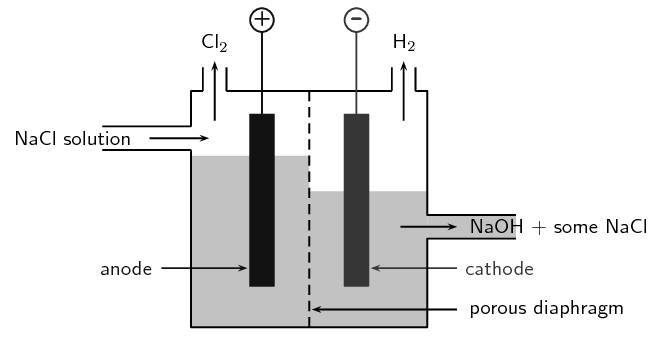
Brine solution on electrolysis will give:
(A) $NaOH$
(B) ${{O}_{2}}$
(C) $C{{l}_{2}}$
(D) ${{H}_{2}}$
Answer
216.3k+ views
HINT: Brine solution refers to the high concentration of salt (NaCl) in water (H2O). Electrolysis is the process in which ionic substances are broken into simpler substances when an electric current is passed through it.
Complete step by step solution:
Brine solutions have the composition of sodium chloride (NaCl) and water (H2O). Other useful chemicals which we will get in this process, sodium hydroxide (NaOH) and hydrogen (H2). The chlorine and sodium hydroxide produced in the process have to be separated in the reaction when they come in contact with each other.

As we know electrolysis is done on the two electrodes which are cathode electrode and the anode electrode.
-Electrolysis on the negative cathode electrode
The negative cathode attracts the Na+ (from sodium chloride) and H+ ions (from water). The only ions discharged at the cathode are Hydrogen ions. More is the reactivity of the metal is, the less readily there is the presence of reduced ions on the electrode surface. Hydrogen ions get reduced by gaining electrons and give hydrogen molecules at the negative electrode which attracts positive ions towards itself.
$2H+\left( aq \right)+2{{\text{e}}^{-}}\to {{H}_{2}}\left( g \right)$
Other equations:
$2{{H}_{2}}O+2{{\text{e}}^{-}}\to {{H}_{2}}\left( g \right)+20{{H}^{-}}\left( aq \right)$
-Electrolysis on the positive anode electrode
The positively charged anode attracts the negative hydroxide OH ions (from water) and chloride Cl ions (from sodium chloride) towards itself. The chloride ion only is discharged in significant quantities during the process which means that it is preferentially oxidized to chlorine.
The chloride ions are oxidized by electron loss to offer chlorine molecules at the positive electrode which attracts negative ions.
\[C{{l}_{2}}\to 2C{{l}^{}}+2{{e}^{-}}\]
The hydroxide ion, with the uncharged sodium ion, from
\[N{{a}^{+}}+OH\to NaOH\]
Thereby, the answer to the above multiple questions is:
\[NaOH,\ C{{l}_{2}},\ {{H}_{2}}\]
As all three options (A), (C) and (D) are answers to this question and given out in the process of brine electrolysis.
Note:-Electrolysis is where ionic compounds are separated to form simple compounds.
-Electrolysis works only if the compound contains ions. Covalent compounds cannot behave as electrolytes because they contain natural atoms in it, these atoms are joined together by covalent bonds rather than ionic bonds.
Complete step by step solution:
Brine solutions have the composition of sodium chloride (NaCl) and water (H2O). Other useful chemicals which we will get in this process, sodium hydroxide (NaOH) and hydrogen (H2). The chlorine and sodium hydroxide produced in the process have to be separated in the reaction when they come in contact with each other.

As we know electrolysis is done on the two electrodes which are cathode electrode and the anode electrode.
-Electrolysis on the negative cathode electrode
The negative cathode attracts the Na+ (from sodium chloride) and H+ ions (from water). The only ions discharged at the cathode are Hydrogen ions. More is the reactivity of the metal is, the less readily there is the presence of reduced ions on the electrode surface. Hydrogen ions get reduced by gaining electrons and give hydrogen molecules at the negative electrode which attracts positive ions towards itself.
$2H+\left( aq \right)+2{{\text{e}}^{-}}\to {{H}_{2}}\left( g \right)$
Other equations:
$2{{H}_{2}}O+2{{\text{e}}^{-}}\to {{H}_{2}}\left( g \right)+20{{H}^{-}}\left( aq \right)$
-Electrolysis on the positive anode electrode
The positively charged anode attracts the negative hydroxide OH ions (from water) and chloride Cl ions (from sodium chloride) towards itself. The chloride ion only is discharged in significant quantities during the process which means that it is preferentially oxidized to chlorine.
The chloride ions are oxidized by electron loss to offer chlorine molecules at the positive electrode which attracts negative ions.
\[C{{l}_{2}}\to 2C{{l}^{}}+2{{e}^{-}}\]
The hydroxide ion, with the uncharged sodium ion, from
\[N{{a}^{+}}+OH\to NaOH\]
Thereby, the answer to the above multiple questions is:
\[NaOH,\ C{{l}_{2}},\ {{H}_{2}}\]
As all three options (A), (C) and (D) are answers to this question and given out in the process of brine electrolysis.
Note:-Electrolysis is where ionic compounds are separated to form simple compounds.
-Electrolysis works only if the compound contains ions. Covalent compounds cannot behave as electrolytes because they contain natural atoms in it, these atoms are joined together by covalent bonds rather than ionic bonds.
Recently Updated Pages
Difference Between Alcohol and Phenol: Structure, Tests & Uses

Classification of Drugs in Chemistry: Types, Examples & Exam Guide

JEE Atomic Structure and Chemical Bonding important Concepts and Tips

JEE Amino Acids and Peptides Important Concepts and Tips for Exam Preparation

Electricity and Magnetism Explained: Key Concepts & Applications

Chemical Properties of Hydrogen - Important Concepts for JEE Exam Preparation

Trending doubts
JEE Main 2026: Application Form Open, Exam Dates, Syllabus, Eligibility & Question Papers

Derivation of Equation of Trajectory Explained for Students

Hybridisation in Chemistry – Concept, Types & Applications

Understanding the Angle of Deviation in a Prism

Understanding Collisions: Types and Examples for Students

How to Convert a Galvanometer into an Ammeter or Voltmeter

Other Pages
NCERT Solutions For Class 12 Chemistry Chapter 1 Solutions - 2025-26

NCERT Solutions for Class 12 Chemistry Chapter Chapter 7 Alcohol Phenol and Ether

NCERT Solutions ForClass 12 Chemistry Chapter Chapter 8 Aldehydes Ketones And Carboxylic Acids

JEE Advanced Marks vs Ranks 2025: Understanding Category-wise Qualifying Marks and Previous Year Cut-offs

Haloalkanes and Haloarenes Class 12 Chemistry Chapter 6 CBSE Notes - 2025-26

Solutions Class 12 Chemistry Chapter 1 CBSE Notes - 2025-26




